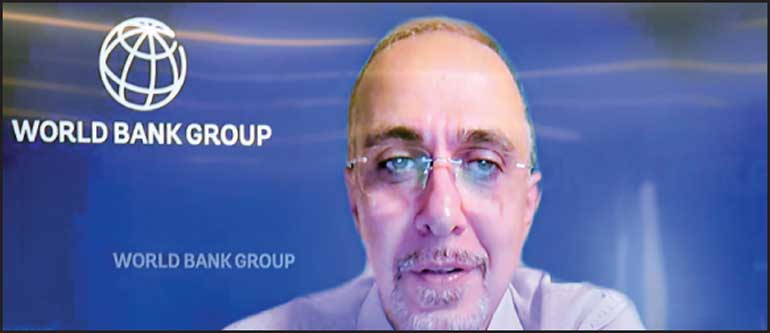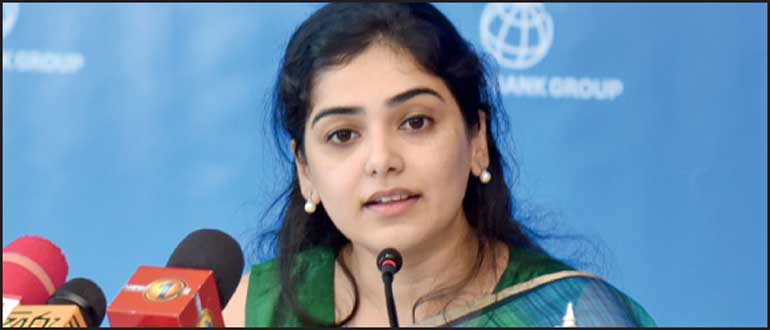Friday Dec 05, 2025
Friday Dec 05, 2025
Wednesday, 8 October 2025 00:00 - - {{hitsCtrl.values.hits}}

World Bank Country Manager for
Sri Lanka and the Maldives
Gevorg Sargsyan

World Bank Country Economist for Sri Lanka Shruti Lakhtakia
By Devan Daniel
Sri Lanka’s economy is expected to grow by 4.6% in 2025, supported by a modest rebound in industry and steady growth in services, before slowing to 3.5% in 2026, according to the World Bank’s latest Sri Lanka Development Update titled ‘Better Spending for All’.
The report, launched yesterday in Colombo, warns that the recovery remains fragile and heavily dependent on the country’s ability to implement deep and sustained reforms.
Speaking at the launch, World Bank Country Manager for Sri Lanka and the Maldives Gevorg Sargsyan said the country’s economy had shown encouraging signs of recovery in the first half of 2025, growing by around 5% as industrial activity rebounded and services expanded.
“We have seen people spending and investing more, inflation returning to low and stable levels, and businesses benefiting from easier access to credit,” he said speaking via video conference from Washington D.C. where he is attending the IMF/World Bank Annual Meetings also attended by senior Sri Lankan officials.
He noted that Government finances had improved with stronger revenue collection, a smaller deficit, and stable foreign reserves, reflecting “the determination and effort of the Sri Lankan Government and people from all walks of life.”
However, he cautioned that the journey was far from over. “The economy is still not back to where it was in 2018, and while poverty is expected to fall this year, it is still twice as high as it was before the crisis in 2019,” he said.
Sargsyan said that about 22% of the population still lives below the poverty line and another 10% remains just above it. Malnutrition remains a serious concern, while the job market is recovering too slowly, with wages and employment rates still at pre-crisis levels.
Looking ahead, the World Bank said that growth will likely remain modest unless Sri Lanka moves quickly to implement strong and urgent reforms.
“Without these reforms, growth will likely come from people’s spending rather than from new investments and exports. Without these reforms, progress could even stall, and the benefits of recovery may not reach everyone,” Sargsyan said.
He identified four key areas for reform: trade, investment, taxation, and job creation. “Sri Lanka needs to keep policies stable and consistent, and move quickly to remove barriers to trade, improve the investment climate, modernise the tax system, and make it easier for businesses to grow and create jobs,” he said.
Sargsyan stressed that private sector-led growth was the only viable path for the time being. “Currently, in Sri Lanka, there is no fiscal space in the public sector. The Government doesn’t have the opportunity to use its own investments to facilitate growth,” he said.
“Hence, private sector-led growth is the only viable option for Sri Lanka for the time being.”
He also highlighted inefficiencies in public spending, noting that around 80% of Government expenditure is allocated to public sector salaries, welfare programs, and interest payments.
“While there is limited room to drastically increase or cut overall public expenditure, there is significant potential to improve the efficiency and impact of existing spending,” he said.
Sargsyan said that smarter spending could create fiscal space for growth-enhancing investment in infrastructure, education, and health. “Public investment and public sector wages reform can ensure that every rupee of public money is spent well and delivers more for the people,” he said.
He welcomed the establishment of a new public investment program system to serve as a unified pipeline for Government projects, calling it “one of the key building blocks” for more effective spending.
“Sri Lanka has made real progress, but there is still much to do,” Sargsyan noted.
“The recovery is fragile, and many vulnerable citizens have not yet felt its benefits. By focusing on smarter spending, meaningful reforms, and inclusive growth, Sri Lankans can look forward to a stronger, more resilient recovery. And we, the World Bank Group, stand ready to support Sri Lanka in this journey,” he said.
World Bank Country Economist for Sri Lanka Shruti Lakhtakia said the economy’s recovery had continued for a second year, with growth of 4.8% in the first half of 2025 driven primarily by household consumption. “High-frequency indicators such as cement consumption show improvement, a good sign for industry, but activity remains below pre-crisis levels,” she said. Inflation turned positive after months of deflation, allowing the Central Bank to cut rates and fuel private credit growth, which reached nearly 20% in July.
She said Sri Lanka’s external balances had held up due to tourism and remittances, even as the trade deficit widened. “The current account has remained in surplus this year, but reserve accumulation has slowed, and the rupee has depreciated,” she said.
Fiscal buffers have strengthened because of higher import tax revenues and lower capital spending, though under-execution of the capital budget was a concern. “We project a primary surplus above the Government’s 2.3% of GDP target, but this has come partly from reduced capital investment,” she said.
Lakhtakia said poverty had begun to decline, but vulnerability remained high. “We expect around 22.5% of the population to be below the poverty line this year and another 10% just above it,” she said.
“Continuous food price increases have contributed to food insecurity and worsening child malnutrition, with more underweight and stunted children under five.” The labour market, she said, was improving but had not yet reached pre-crisis levels in either participation or real wages.
Looking ahead, Lakhtakia said the outlook for 2025 was positive, with strong growth projected, but the path was narrow and dependent on policy consistency. “We expect the current account surplus to persist, supported by tourism and remittances, though merchandise exports may be affected by new tariffs,” she said.
“The key is to maintain reform momentum in trade, fiscal policy, and public spending.”
Lakhtakia, presenting findings from the World Bank’s Public Finance Review published in September, said spending reform was a core priority. “Sri Lanka’s total Government spending is low compared to peers, but 80% of it is rigid, locked in salaries, transfers, and interest payments,” she said.
The public wage bill as a share of GDP is relatively small, but the headcount is high, resulting in lower average wages and inequities across the public sector. “If we include SOEs and Government-funded institutions, public employment would be about 3% higher than reported,” she said.
She recommended preserving frontline workers in health and education to protect service delivery, while allowing natural attrition in overstaffed sectors.
“A comprehensive review of base pay versus allowances could help systematise the wage structure,” she said. She also called for modernising the payroll system to increase transparency and efficiency.
On public investment, Lakhtakia said Sri Lanka’s stock of public assets was low and declining, with investment concentrated in sectors like transport.
“It is critical to improve the link between capital spending and infrastructure needs, complete projects more quickly, and maintain assets to extend their life,” she said.
She added that the new public investment management system should streamline project planning, screening, approval, and monitoring, supported by better data to prioritise spending.
Lakhtakia said maintenance spending had risen recently, which was a positive sign, and encouraged the Government to continue this trend to maximise the lifespan of assets.
“Better targeting, reallocation of resources to high-impact projects, and stronger implementation through the Public Financial Management Act will be key,” she said.
The World Bank economists concluded that while Sri Lanka had made significant progress in stabilising its economy, sustaining growth and reducing poverty would depend on reforms that promote competitiveness, attract private investment, and make public spending more equitable and effective.